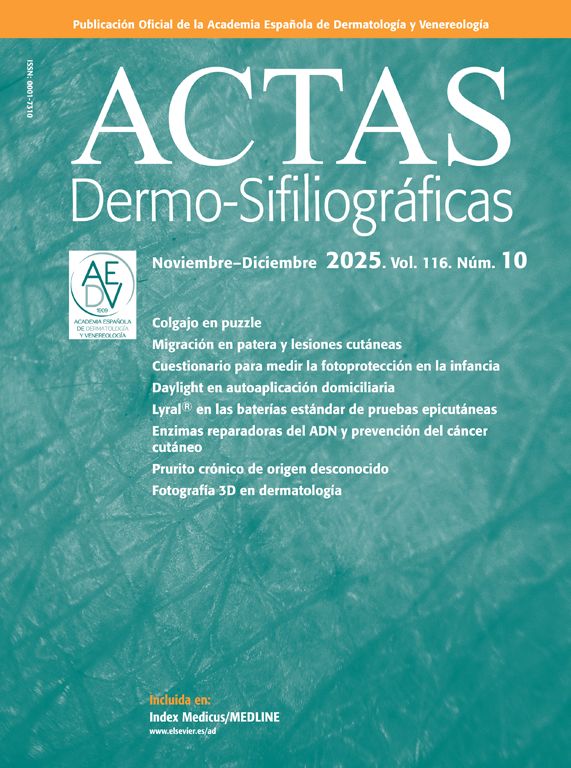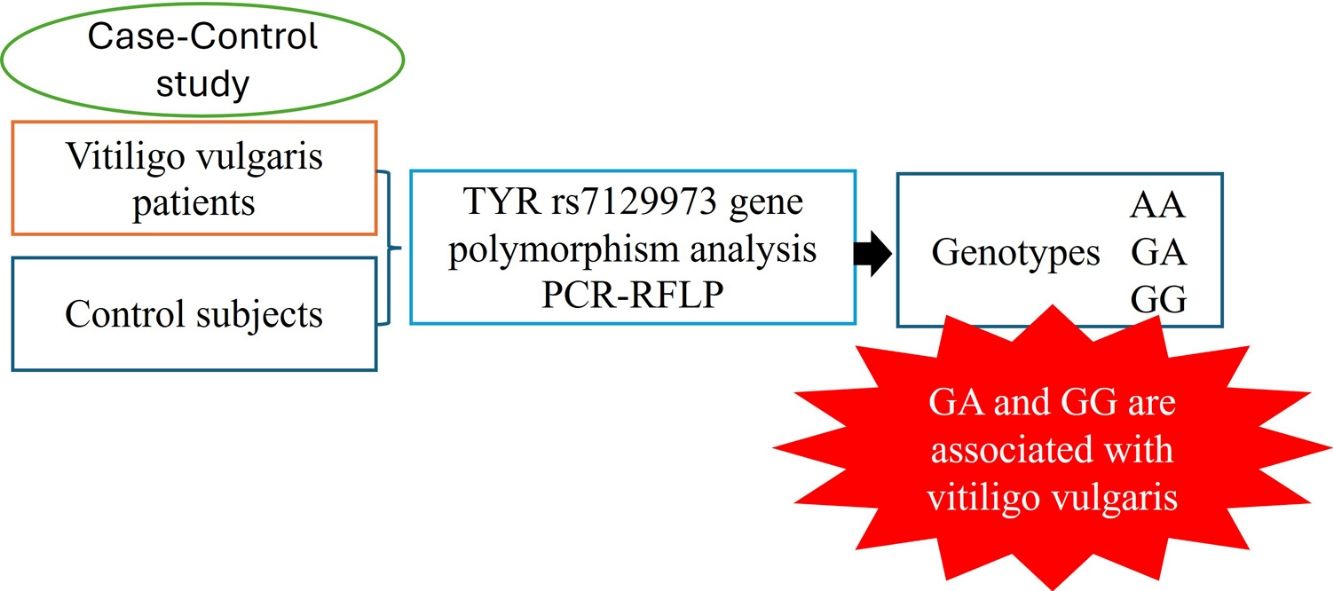Vitiligo is a multifactorial disease characterized by skin depigmentation. Although there are several genetic components involved in its development, the participation of the TYR rs7129973 gene polymorphism has not yet been explored. Our objective was to evaluate the association between vitiligo vulgaris and the TYR rs7129973 gene polymorphism in a Mexican population. Therefore, a total of 84 vitiligo vulgaris patients and 90 control subjects from northeastern Mexico were analyzed through PCR-RFLP to determine the association between vitiligo and TYR rs7129973. We found that the carriers of TYR rs7129973 G alleles (AG and GG genotypes) were more prevalent among patients with vitiligo (P<0.05). However, this genetic variant had no correlation with the age of onset, vitiligo activity, family history of vitiligo, and personal history of thyroid disease (P>0.05). Thereby, we can conclude that the TYR rs7129973 polymorphism constitutes a risk factor for the development of vitiligo vulgaris in the Mexican population.
El vitíligo es una enfermedad multifactorial caracterizada por la despigmentación de la piel. Existen varios componentes genéticos involucrados en su desarrollo, sin embargo, aún no se ha explorado la participación del polimorfismo rs7129973 del gen TYR. Nuestro objetivo fue evaluar la asociación entre el vitíligo vulgar y el polimorfismo rs7129973 del gen TYR en población mexicana. Para esto, fueron analizados 84 pacientes con vitíligo vulgar y 90 sujetos control del noreste de México mediante PCR-RFLP para determinar la asociación entre vitíligo y rs7129973 TYR. Descubrimos que los portadores del alelo G (genotipos AG y GG) para rs7129973 TYR eran más prevalentes entre los pacientes que padecían vitíligo (P <0.05). Esta variante genética no tuvo correlación con la edad de aparición, la actividad del vitíligo, los antecedentes familiares de vitíligo ni con los antecedentes personales de enfermedad tiroidea (P>0.05). Por lo tanto, podemos concluir que el polimorfismo rs7129973 TYR constituye un factor de riesgo para el desarrollo de vitíligo vulgar en la población mexicana.
Vitiligo is a multifactorial disease characterized by skin depigmentation caused by the lack of melanin.1 This disease has an estimated prevalence of 0.5–2%2 worldwide. And, in Mexico, it ranks #3 up to #5 amongs known cases of dermatoses, with non-segmental vitiligo (NSV) being the most common clinical presentation (85–90%).3
The pathogenesis of vitiligo is not completely understood, although it is believed to be of polygenic and multifactorial nature (e.g., it includes genetic, environmental, metabolic factors and autoimmune responses).4 Several genes and genomic regions have been associated with susceptibility to vitiligo, as suggested by linkage analysis and candidate gene studies.5 The normal pigmentation mechanism involves the participation of 2 important cell types in the skin, e.g., melanocytes and keratinocytes. Melanin, whose synthesis is performed by melanocytes, is a natural pigment derived from tyrosine catalysis by the tyrosinase enzyme,4 encoded in the gene TYR, 11q14–q21. Therefore, pathogenic mutations inherited or acquired therein can result in complete or partial oculocutaneous albinism.6 In addition, genome wide association studies suggest a significant association between generalized vitiligo and single nucleotide polymorphisms (SNPs) in TYR, e.g. rs1393350 and rs1847134.7 On the other hand, the participation of the TYR rs7129973 gene variant in skin pigmentation has been explored in recent years, suggesting a link with 25-hydroxyvitamin D 25(OH)D concentration in serum.8 However, this polymorphism has not yet been associated with the development of vitiligo. Thus, this case-control study explored whether the TYR rs7129973 gene polymorphism (A→G change in the intronic region of the TYR gene) is indeed associated with vitiligo in a Mexican population.
Material and MethodsSubjectsPatients with vitiligo vulgaris and healthy controls without a family history of vitiligo were recruited at the Dermatology Department of Hospital Universitario “Dr. José Eleuterio González” in Monterrey, Mexico from May 2023 through May 2024. A total of 84 vitiligo patients (70 women and 14 men) who met the inclusion criteria: Mexican subjects older than 18 years of both sexes, diagnosed with vitiligo vulgaris; and 90 healthy controls (74 women and 16 men) older than 18 years with a negative history of vitiligo and autoimmune/inflammatory diseases were included in this study. All patients were assessed by a dermatologist. This study was approved by Hospital Universitario “Dr. José Eleuterio González”-UANL Research and Ethics Committee (code DE19-00013). All participants gave their prior written informed consent.
DNA IsolationA phenol-chloroform extraction was used to isolate genomic DNA from peripheral venous blood from each individual followed by precipitation in absolute ethanol.9 The DNA pellet was resuspended in Tris–EDTA (pH 7.8) at a final concentration of 0.1–1.0μg/μL and stored at −20°C until used for genetic analysis.
GenotypingThe allele frequency of TYR rs7129973 was characterized by PCR-RFLP using a Labnet Multigene OPTIMAX TC9610 thermal cycler (Labnet International; NJ, United States). Primers for TYR rs7129973 (5′-AACGTTAGCTCCAATGCTAACATAC-3′ and 5′-ACCTTGCTTCATCTTCTCTCTTGTA-3′) were obtained from IDT (Coralville; IA, United States). The endonuclease HpyCH4III (New England Biolabs; MA, United States) was used in the restriction analysis according to previously published protocols.10 All digested products were analyzed by electrophoresis in a 2% agarose gel stained with ethidium bromide and visualized in a UVP model 2 UV High-Performance Transilluminator (Upland; CA, United States).
Statistical AnalysisThe sample size was estimated according to vitiligo prevalence in Mexico (4%) and with a 99.5% statistical power (Z=2.33), resulting in a minimum sample of 84 subjects.4 The SPSS v21.0 software for windows (IBM, IL; United States) and the Epi-INFO™ 7 statistical program (CDC, United States) were used in the statistical analysis. A Student's t or Mann–Whitney U test for comparisons between 2 groups were used. ANOVA or Kruskal–Wallis H tests were applied for comparisons across 3 groups according to parametric or nonparametric distribution. Tukey, Bonferroni, Tamhane and Dunnet T3 post hoc tests were used for pair-wise comparisons. A Hardy-Weinberg equilibrium test was obtained for the alleles using a goodness-of-fit test, whereas the genotypic dependence between patients and control subjects was determined with a chi-square test. The following gene models were used to assess the association between gene polymorphism and vitiligo vulgaris: dominant (AA vs GA+GG), recessive (GG vs AA+GA), and allele model (A vs G). Any associations between vitiligo and gene polymorphism were detected using logistic regression analyses. Odd ratios were calculated from 2×2 contingency tables. A P<0.05 was considered significant after the Bonferroni correction.
ResultsClinical ParametersThe age of the participants was of 41.3±9.2 years (median, 42.5; range, 51.0) for vitiligo patients and 38.2±12.0 years (median, 35.5, range, 44.0) for healthy controls (P=0.090). The 84 patients included in this study were diagnosed with vitiligo vulgaris according to the clinical sign of the disease. Activity, age of onset, and family history of vitiligo are shown in Table 1. A total of 43 patients (51.2%) had, at least, 1 relative with vitiligo, and 53 (63.1%) of the patients exhibited the disease at ≤30 years of age (e.g., age of onset).
Four of the patients included had type 2 diabetes mellitus (T2DM, 4.8%) and 24 (28.6%) a personal history of thyroid disorders (Table 2), of which hypothyroidism and subclinical hypothyroidism represented 23.8% and 4.8% respectively.
Association Between TYR rs7129973 and VitiligoWe investigated whether the TYR rs7129973 variant is associated with vitiligo in a sample of Mexican patients and healthy control subjects. The results of our evaluation showed no deviation based on the Hardy–Weinberg equilibrium for control subjects (P=0.534) and vitiligo patients (P=0.870). Furthermore, the comparison of TYR rs7129973 genotype and/or allele frequency between vitiligo and control subjects revealed that the A allele genotypes had a greater frequency across the cohort; in contrast, a clear association could be seen between G allele genotypes and the presence of vitiligo (P=0.004 (Table 3). Furthermore, it was observed that 53 subjects had an age of onset<30 years of age, and no significant relation was observed between this variable and the genotype (AA: 23.63±13.81/GA: 22.87±13.37; P=0.898/GG: 23.54±10.50; P=0.982/GA+GG: 23.04±12.65; P=0.933). Moreover, when stratifying by age of onset (P=0.646), vitiligo activity (P=0.499), family history of vitiligo (P=0.270), and personal history of thyroid disease (P=0.139), no association was observed in relation to TYR rs7129973 genotype (Table 4).
TYR rs7129973 genotype frequency in patients with vitiligo and healthy control subjects.
| Genotype | Vitiligo (%) | Controls (%) | Chi-square test | OR | 95 CI | P | Pc |
|---|---|---|---|---|---|---|---|
| AA | 30 (35.7) | 51 (56.7) | 8.16 | 0.017 | 0.018 | ||
| GA | 41 (48.8) | 32 (35.6) | 5.65 | 2.18 | 1.14–4.16 | 0.017* | 0.018 |
| GG | 13 (15.5) | 7 (7.8) | 5.13 | 3.16 | 1.134–8.79 | 0.024* | 0.028 |
| GA+GG | 54 (64.3) | 39 (43.3) | 7.67 | 2.35 | 1.28–4.36 | 0.006* | 0.018 |
| AA | 30 (35.7) | 51 (56.7) | |||||
| GG | 13 (15.5) | 7 (7.8) | 2.53 | 2.17 | 0.82–5.74 | 0.112* | 0.479 |
| AA+GA | 71 (84.5) | 83 (92.2) | |||||
| Alleles | |||||||
| A | 101 (60.1) | 134 (74.4) | 8.13 | 0.52 | 0.33–0.82 | 0.004* | 0.005 |
| G | 67 (39.9) | 46 (25.6) | |||||
OR, odds ratio; CI, confidence interval; (*) corrected P value; Pc: value supported by logistic regression.
TYR rs7129973 genotype, age of onset, vitiligo activity, family history of vitiligo, and personal history of thyroid disease.
| Age of onset | <30 years, n (%) | >30 years, n (%) | Chi-square test | OR | 95%CI | P |
|---|---|---|---|---|---|---|
| AA | 17 (32.1) | 13 (41.9) | 0.87 | 0.646 | ||
| GA | 27 (50.9) | 14 (45.2) | ||||
| GG | 9 (17.0) | 4 (12.9) | ||||
| AA | 17 (32.1) | 13 (41.9) | 0.83 | 1.53 | 0.61–3.83 | 0.363* |
| GA+GG | 36 (67.9) | 18 (58.1) | ||||
| Vitiligo activity | Yes, n (%) | No, n (%) | Chi-square test | OR | 95% CI | P |
|---|---|---|---|---|---|---|
| AA | 21 (40.4) | 9 (28.1) | 1.39 | 0.499 | ||
| GA | 24 (46.1) | 17 (53.1) | ||||
| GG | 7 (13.5) | 6 (18.8) | ||||
| AA | 21 (40.4) | 9 (28.1) | 1.30 | 0.58 | 0.22–1.49 | 0.255* |
| GA+GG | 31 (59.6) | 23 (71.9) | ||||
| Family history of vitiligo | Yes, n (%) | No, n (%) | Chi-square test | OR | 95% CI | P |
|---|---|---|---|---|---|---|
| AA | 16 (37.2) | 14 (34.1) | 2.62 | 0.270 | ||
| GA | 18 (41.9) | 23 (56.1) | ||||
| GG | 9 (20.9) | 4 (9.8) | ||||
| AA | 16 (37.2) | 14 (34.1) | 0.09 | 0.88 | 0.36–2.14 | 0.770* |
| GA+GG | 27 (62.8) | 27 (65.9) | ||||
| Thyroid disease | Yes, n (%) | No, n (%) | Chi-square test | OR | 95% CI | P |
|---|---|---|---|---|---|---|
| AA | 10 (41.7) | 20 (33.3) | 3.95 | 0.139 | ||
| GA | 8 (33.3) | 33 (55.0) | ||||
| GG | 6 (25.0) | 7 (11.7) | ||||
| AA | 10 (41.7) | 20 (33.3) | 0.52 | 1.42 | 0.52–3.81 | 0.471* |
| GA+GG | 14 (58.3) | 40 (66.7) | ||||
OR, odds ratio; CI, confidence interval; (*) corrected P value.
Vitiligo is a multifactorial skin disorder characterized by skin depigmentation caused by melanocyte dysfunction, usually of genetic and immunological origin.4,11 Some of the studied genes are involved in melanocyte homeostasis and melanogenesis, both of which are essential in melanin synthesis, e.g., tyrosinase.12 Tyrosinase (TYR) is directly involved in L-DOPA oxidation into dopachrome and melanin13 and is a target for the treatment of over-pigmentation disorder and associated skin problems.14 Tyrosinase (TYR) gene is located in chromosome 11q14.3 and encodes a 529 amino acid protein coded in 5 exons.15 Several TYR gene variations are associated with the development of oculocutaneous albinism (OCA),16 whereas rs1042602 (S192Y) and rs1126809 (R402Q), which are commonly non-synonymous polymorphisms observed in European people, might be involved with generalized vitiligo.17 Other TYR gene variants have been associated in this regard through genome-wide association studies, among which rs10830236, rs11018528, rs10765198, rs1847134, rs1393350, and rs1806319 are widely observed in North American and British patients.7
The TYR intron variant rs7129973 is involved in skin pigmentation and 25-hydroxyvitamin D (25[OH]D) serum concentration variations in Caucasian people,8 and skin hyperpigmentation in pregnant women from Taiwan.10 The studies conducted on this issue highlighted the differential frequency of some genotypes, e.g., GA, common in German people (38.5%; n=2970); and AA, common in Taiwanese women with melasma (58.9%; n=56). In our study, the most common genotype was AA (46.6%; n=174); however, the GA genotype (48.8%) was more frequently observed in subjects with vitiligo (Table 3).
As far as we know, this is the first evaluation of TYR gene polymorphisms in a Latin-American population with vitiligo vulgaris. In this study, the presence of TYR rs7129973 G alleles (AG and GG) was directly associated with vitiligo (P<0.05), as could be observed through the analysis of different genotypes, as through the analysis considering the dominant genetic model (Table 3). Alternatively, no statistical differences were observed regarding TYR gene polymorphisms and the clinical parameters of said vitiligo patients (e.g., age of onset, vitiligo activity, family history of vitiligo, and personal history of thyroid disease) (Table 4).
ConclusionsOur study suggests that the TYR rs7129973 polymorphism is associated with the development of vitiligo vulgaris in the Mexican population, mainly in those carrying the G allele variants. Furthermore, these polymorphisms had no correlation with age of onset, vitiligo activity, family history of vitiligo, and personal history of thyroid disease in the included subjects. Lastly, this study reinforces the role of tyrosinase in the development of vitiligo.
FundingNone declared.
Conflicts of InterestNone declared.









